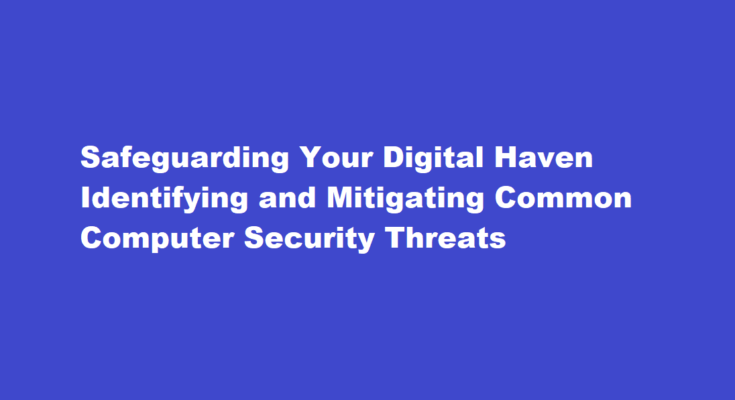Introduction
In today’s interconnected world, computer security is of paramount importance. With the proliferation of technology, our lives have become more dependent on computers and the internet, making us vulnerable to a variety of security threats. This article aims to provide insights into identifying and dealing with common computer security threats to help users protect their digital assets and personal information effectively.
Understanding Common Computer Security Threats
a. Malware Malicious software, or malware, is a broad category that includes viruses, worms, trojans, ransomware, and spyware. These programs are designed to infiltrate and compromise systems, steal data, or cause harm to your computer.
b. Phishing Attacks Phishing is a fraudulent practice where cybercriminals impersonate trustworthy entities to trick users into revealing sensitive information, such as login credentials or financial details.
c. Social Engineering This type of attack manipulates individuals into revealing confidential information or performing actions that compromise security, often through psychological manipulation.
d. DDoS Attacks Distributed Denial of Service (DDoS) attacks overwhelm a target’s network or website with a flood of traffic, rendering it inaccessible to legitimate users.
e. Insider Threats Insider threats arise from individuals within an organization who misuse their access to sensitive data or systems for malicious purposes or inadvertently compromise security.
Identifying Computer Security Threats
a. Keep Software Up-to-Date Regularly update operating systems, applications, and antivirus software to protect against known vulnerabilities.
b. Watch for Phishing Indicators Be cautious about unsolicited emails, spelling errors, suspicious links, and urgent requests for personal information.
c. Monitor Network Traffic Use network monitoring tools to detect unusual patterns or spikes in traffic that may indicate a DDoS attack.
d. Implement Strong Access Controls Limit access to sensitive information and critical systems to authorized personnel only, reducing the risk of insider threats.
e. Analyze System Performance Monitor your computer’s performance for signs of malware infection, such as slow processing or unexpected pop-ups.
Dealing with Computer Security Threats
a. Install Antivirus and Anti-Malware Software Use reputable security software to detect and remove malware from your system regularly.
b. Educate Yourself and Your Team Stay informed about the latest security threats and educate your colleagues or family members about safe computing practices.
c. Secure Networks Set up firewalls and encryption to protect data transmitted over networks, preventing unauthorized access.
d. Use Strong Passwords Create unique, complex passwords for different accounts and consider using password managers to keep track of them securely.
e. Regular Backups Maintain frequent backups of essential data to ensure you can recover it in case of a ransomware attack or hardware failure.
f. Incident Response Plan Develop a comprehensive incident response plan outlining the steps to take in case of a security breach.
g. Reporting If you encounter a security threat or incident, report it to the appropriate authorities, your IT department, or your internet service provider.
Best Practices for Online Security
a. Two-Factor Authentication (2FA) Enable 2FA whenever possible to add an extra layer of protection to your accounts.
b. Use Secure Wi-Fi Networks Avoid using public Wi-Fi networks for sensitive transactions and instead use a VPN to encrypt your internet connection.
c. Regular Audits Conduct periodic security audits to identify vulnerabilities and weaknesses in your system.
d. Secure Email Practices Be cautious with email attachments and links, especially from unknown senders.
e. Limit User Privileges Implement the principle of least privilege, giving users only the minimum access necessary to perform their tasks.
FREQUENTLY ASKED QUESTIONS
What are 4 threats to computer security?
There are several types of computer security threats such as Trojans, Virus, Adware, Malware, Rootkit, hackers and much more. Check some of the most harmful types of computer Security Threats.
What is a computer security threat?
In computer security, a threat is a potential negative action or event facilitated by a vulnerability that results in an unwanted impact to a computer system or application.
Conclusion
Securing your computer and personal information is an ongoing process that requires vigilance and proactive measures. By understanding common computer security threats, identifying their signs, and adopting best practices, users can significantly reduce the risk of falling victim to cyberattacks. Remember, staying informed and practicing safe computing habits are the keys to maintaining a safe digital environment.
Read Also : Mastering The Art of Cooking Perfect Fluffy Rice



